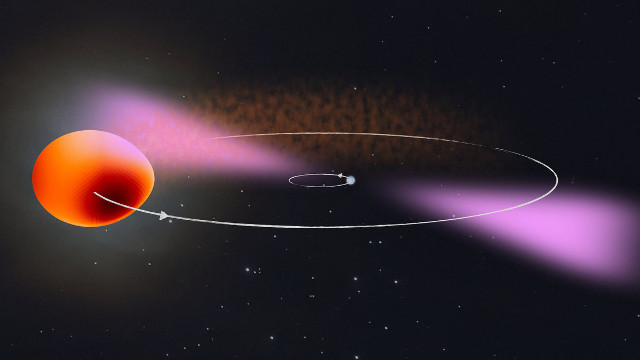
Two articles – available here and here – published in the journal “Monthly Notices of the Royal Astronomical Society” report different aspects of the study that led to the identification of the rare characteristics of a gamma-ray source that turned out to be a pulsar, cataloged as PSR J2039-5617. Two teams with various researchers in common used data collected by the Fermi Space Telescope and other instruments, and relied on the help of citizen scientists participating in the Einstein@Home project to study the pulsar. It’s a rare type of pulsar because it belongs to the millisecond class and also to the so-called redback class, which has a red dwarf as a companion.
The source of electromagnetic emissions in the form of gamma rays but also X-rays and others was known since 2014 and cataloged as 3FGL J2039.6-5618. Previous studies already predicted that they were generated by a pulsar, a neutron star that spins at remarkable speed, with a small normal star as a companion. This was indicated for example in an article published in “The Astrophysical Journal” in November 2015.
Among the emissions of this pulsar there are also radio waves, detected with a period of 2.6 milliseconds, among the evidence that led to the identification of the source as a pulsar, at that point cataloged as PSR J2039-5617. Evidence that a redback-type binary system was still missing, and the help of citizen scientists participating in the Einstein@Home project helped to find them.
Optical telescopes were used to obtain information on the likely companion of the pulsar that would allowt researchers to better understand that binary system and, indirectly, the neutron star. That’s thanks to the variability of the light emitted by the couple depending on which of the two stars is facing the Earth and which is eclipsed by the companion.
A pulsar has a very strong influence on its companion because it steals gas and heats the side exposed to the pulsar. That’s useful in observations, which in this case indicated that the companion of the pulsar PSR J2039-5617 is a red dwarf with a mass about 15% of the Sun’s and that the two stars orbit each other in about 5.5 hours. The interactions between the two stars also cause small alterations in the red dwarf’s orbit caused by both the gravitational field and the magnetic field of the pulsar.
This study of pulsar PSR J2039-5617 confirms the previous ones offering new evidence that it’s a millisecond redback pulsar. This type of binary system is considered rare although several cases have been found in recent years. The combination of various instruments that offer data in different electromagnetic bands helps identify these and other objects. The Fermi Space Telescope has discovered many sources of gamma rays whose nature is still in doubt and a lot of work needs to be done to study them all. Projects like Einstein@Home, which allow citizen scientists to contribute to these studies, help advances in the identification of these extreme objects and in other astronomical research.

